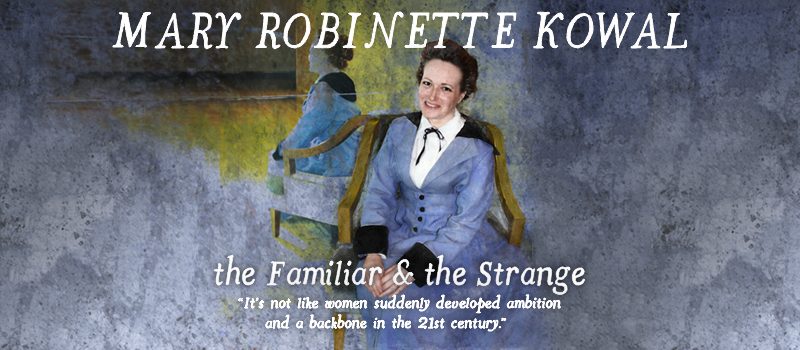Mary Robinette Kowal: The Familiar & the Strange

Mary Robinette Kowal was born Mary Robinette Harrison on February 8, 1969 in Raleigh NC. She attended Eastern Carolina University, majoring in Art Education, with a minor in Theater and Speech. In 1991 she left for an internship at the Center for Puppetry Arts in Atlanta GA and never went back. She has been a professional puppeteer ever since. Kowal spent a year and a half working in Iceland on the children’s television show Lazytown, worked for various other shows and theaters, and ran her own company, Other Hand Productions.
Kowal began publishing fiction in literary journals in 2004, and in SF magazines with ‘‘Portrait of Ari’’ in Strange Horizons (2006). Her work has since appeared in various genre magazines and anthologies. Notable stories include Hugo Award finalists ‘‘Evil Robot Monkey’’ (2008), Hugo winners ‘‘For Want of a Nail’’ (2010) and ‘‘The Lady Astronaut of Mars’’ (2013), and Nebula Award finalist ‘‘Kiss Me Twice’’ (2011). Some of her short fiction was collected in Scenting the Dark and Other Stories (2009) and Word Puppets (2015).
Kowal is also a novelist, notably of the Jane Austen-inspired Glamourist Histories series: Shades of Milk and Honey (2010), Glamour in Glass (2012), Without a Summer (2013), Valour and Vanity (2014), and Of Noble Family (2015). Standalone Ghost Talkers (2016) is a fantasy set during WWI. The Calculating Stars and The Fated Sky, set in the world of ‘‘The Lady Astronaut of Mars’’, are forthcoming as a duology in 2018.
She served as secretary for the Science Fiction and Fantasy Writers of America starting in 2008, and spent two terms as SFWA vice-president starting in 2010. She was the art director for small-press magazine Shimmer. She attended Orson Scott Card’s Literary Boot Camp in 2005, and won the Campbell Award for Best New Writer in 2008. Since 2008 she has been part of the Hugo Award-winning Writing Excuses podcast.
Kowal lives in Chicago IL with husband Robert Kowal, married 2001.
Excerpts from the interview:
‘‘The moment I knew I was setting something during the First World War, I knew that darkness was going to be part of it, and that I would have to work really hard to keep the darkness from completely overwhelming Ghost Talkers. When you do any reading at all about the First World War, it becomes very clear why it made such a huge, permanent mark on Europe – and the US less so, because we were not directly touched by it. It wasn’t even the death tolls, because in England a lot of men actually came home, but everyone came home wounded in some way, either physically or emotionally. I read interview after interview of survivors saying, ‘I went over the top of the trench, and everyone in my platoon died. I don’t know why I lived.’ I knew going in that dealing with someone who deals with ghosts as her job, during WWI, would mean a darker book than people are used to from me. On the other hand, the last book in the Glamourist series, I jokingly refer to as ‘Regency Grimdark.’
‘‘I had already been doing reading about WWI, just because I like history. Ginger Stuyvesant, the heroine, actually comes from some short stories I’d written, and the ideas that make up this book were originally just the backstory. I’d done some research for the stories, but it wasn’t really until I started to get into the novel that I buckled down and did some more research and realized how much perceived knowledge I had about the First World War was completely wrong and very American-centric. You watch these war movies, and it’s all about the men at the battlefront. I did not realize at all how heavily involved women were in the First World War, and how directly tied it was to suffrage. Because all of the men were basically needed as cannon fodder, women were the ambulance drivers and the motorcycle couriers, so all of the orders sent to the front lines were delivered by young women on motorcycles. All of these places where women are right up at the front – nurses in hospitals, doctors in hospitals – they’re all just right there, and that gets completely glossed over and deleted.”
…
‘‘I’m working on the novel that’s coming out in 2018 as part of a pair, The Calculating Stars and The Fated Sky. They’re a prequel to my novelette ‘The Lady Astronaut of Mars’. The year is 1952, and the novel starts five minutes before an asteroid slams into the Earth, into Chesapeake Bay, and wipes out DC. It is about the recovery efforts and the efforts to try to get off the planet, and establish safehold colonies in other places. I am in the first quarter of the second book right now. It’s fun. And again, just going back to that thing where women get written out of history: before I started working on this book I hadn’t realized how heavily involved women were in rocketry. There’s a film coming out, Hidden Figures, which I’m super excited about because it’s talking about the role of African American women in the early NASA program. Women and women of color were present from the ’40s. The Jet Propulsion Laboratory’s entire computing department was women, and there’s a great book about that called The Rise of the Rocket Girls. Back then the word ‘computer’ meant someone who computed. There’s a theory, which I find fascinating and unprovable, that the reason why computer voices in the US tend to be women is because back in the early days, all of the computers were women, and when you asked for a readout, you heard a feminine voice. In Europe, like in Germany for instance, computer voices tend to be male.”
…
‘‘When we were living in Iceland, there was a period of two months, because I’d gone there for my work in puppetry, when my husband was a house husband. I’d come home from work and the laundry was done, he had dinner on the table, he had a cocktail waiting for me, and I was like, ‘This is why men did not want women to get jobs. Because this is amazing.’ I would come home and I wouldn’t have to make any decisions.
‘‘In puppeteering, I had a very brief stint with Sesame Street. The project I’m working on now is for the House Theatre here in Chicago, and it’s an adaptation of Alastair Reynolds’s Diamond Dogs. I’m building the puppets for that. I’m also building a polar bear for a children’s hospital in Iceland. That’s a full-size body suit. Periodically you’ll hear me talking about ‘building the bear.’”
…
‘‘I did the narration for the audiobook of Ghost Talkers. There are house styles. I’m fortunate that I work for two companies whose styles are the same as my own, which is that they prefer an emotionally invested narrator, as opposed to a neutral read. The neutral read is easier to do. It doesn’t take as much work. But as a listener, I find those dull, and I find them very easy to tune out. I prefer listening to things with an emotionally invested narrator, so that means that when I’m doing the accents, I’m trying to create for the listener the experience that I have when I’m reading the work. This is the way I hear these characters. There are two things that make it easier to do my own books. One is that the rhythms naturally match my own voice. The other is because I’ve made a deal with the publisher, Audible. Normally you record audiobooks from the final proof, which is the thing that’s going to be printed, but we record mine from the first pass proof, so the moment it’s typeset, we go in and record. Whenever I read a book, whether it’s mine or someone else’s, I find mistakes, and this allows me to make the changes, send them in to Tor, and get them in to the printed version.”
Read the complete interview in the January 2017 issue of Locus Magazine. Interview design by Francesca Myman.






